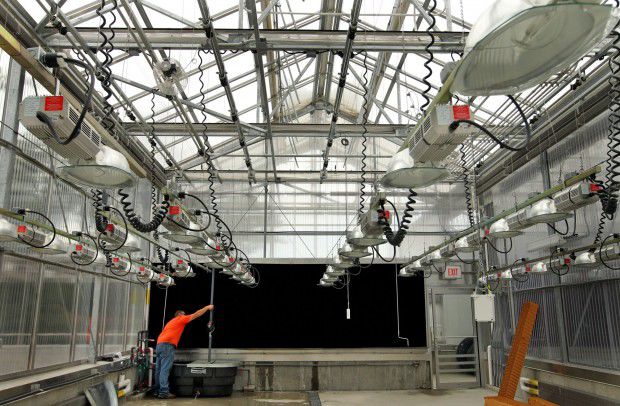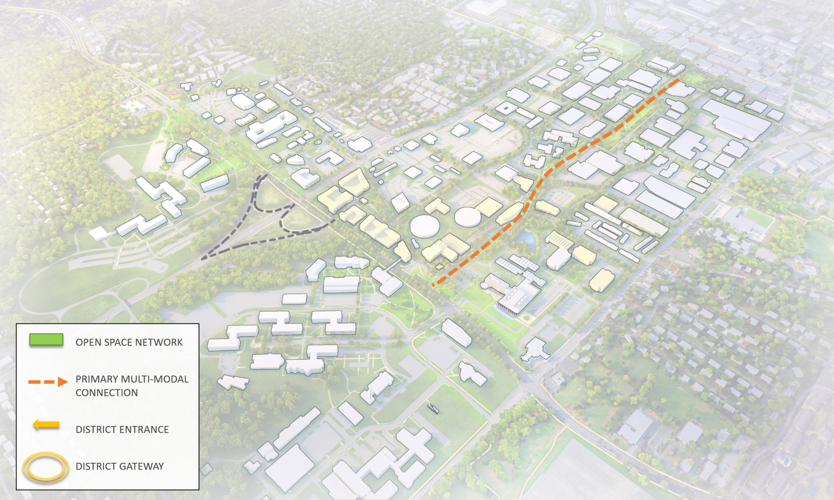Economic development officials are hoping to replicate the success of the Cortex technology district in the suburbs.
MonsantoŌĆÖs headquarters and the Donald Danforth Plant Science Center already serve as anchors of the Creve Coeur hub of agriculture technology, while BRDG Park and the Helix Center offer space for startups and companies that want to be near the research performed there.
But the amenities and density that often help attract a highly educated workforce are somewhat lacking in a suburb developed when planners thought of little more than accommodating cars.
Now, area leaders are planning trails and connections to food and entertainment, attributes many believe are necessary to continue attracting the top-notch scientific talent that drives biotech investment.
ŌĆ£The folks who come here from places like the [San Francisco] Bay Area, like Boston or Austin, Texas, when we ask them what would make it more attractive, they say things like walkability, connectivity, density,ŌĆØ said Sam Fiorello, chief operating officer of the Donald Danforth Plant Science Center and president of the adjacent lab and office space building known as BRDG Park. ŌĆ£We have some of the top scientists in the world. We want to make sure they stay here and their roots get deep.ŌĆØ
People are also reading…
Aided by a $500,000 grant from the U.S. Commerce Department, the ├█č┐┤½├Į Economic Development Partnership has been working for a year to develop around Olive and Lindbergh boulevards. TheyŌĆÖll soon unfurl a branding campaign for the district, but the Partnership will also be looking to fund concrete construction projects.
Within the next couple of years, the draft plan calls for rebuilding the Olive and Lindbergh intersection. By removing the clover leaf interchange, it will open up additional land for development. Also included are plans to connect Old Olive Street at Lindbergh. The street doesnŌĆÖt cross the major road, limiting access to the shops and restaurants to the west of the plant science district.
A top priority is a pedestrian and bicycle path that connects Olive with Baur Boulevard to the north, providing a walkable connection between ├█č┐┤½├Į CountyŌĆÖs incubator and the Danforth Center and BRDG Park. Right now, thick brush blocks the connection to the ag-tech incubator from the Danforth property, forcing a car trip on busy roads to get around what would otherwise be a 5-minute walk.
Eventually, that connector running through the area could link up with the Centennial Greenway, planned to run along the railroad tracks just north of Baur and connect all the way to Forest Park and Clayton.
ŌĆ£This gets people excited because I donŌĆÖt have to jump in my car twice a day to move around the district,ŌĆØ said Janet Wilding, the Economic Development PartnershipŌĆÖs vice president of major projects.
In addition to the infrastructure projects, the Partnership plans to solicit interest from developers for a new mixed-use structure. The Danforth Center has offered some of its open land near the current Plant Science Center for construction of the new building, which officials said would probably be privately built with public incentives.
A gathering place is planned for the ground floor ŌĆö maybe a restaurant, a caf├® or even a brewpub, Wilding said. Upper floors could have incubator space and
├█č┐┤½├Į Economic Development Partnership CEO Sheila Sweeney mentioned based out of the Helix Center, as a potential tenant.
ŌĆ£We just see them as maybe growing out of Helix,ŌĆØ Sweeney said.
Wilding hopes a major university might be interested in having a presence in the districtŌĆÖs new building, and Fiorello hopes to collaborate with in Cortex for a similar weekly networking event in the new buildingŌĆÖs public space. A farmers market, also, might become a regular activity in the district.
ŌĆ£Those programmatic pieces are as important, if not more important, than the physical pieces of infrastructure,ŌĆØ Fiorello said.
Planning for growth
In a case of fortunate timing, Creve Coeur is wrapping up an update to its comprehensive land-use plan just as the plant science district plan is nearing completion.
Creve CoeurŌĆÖs draft comprehensive plan calls for adopting the plant science district plan as an addendum to the document, calling the effort ŌĆ£likely Creve CoeurŌĆÖs and the regionŌĆÖs largest economic development project and job creator for the next 20 years.ŌĆØ
New apartment buildings are already being built, catering to a younger clientele with pools, fitness centers, yoga studios and game rooms. One of the complexes on Old Olive Street, the ŌĆ£Vue at Creve Coeur,ŌĆØ will be ready for move in by January, while just down the street, the 174-unit Vanguard Heights began leasing early this year.
They arenŌĆÖt the kind of apartments built in the 1970s and ŌĆÖ80s in Creve Coeur, city planning director Jason Jaggi said.
Though there was some initial pushback to multifamily housing development, Jaggi said that the area along Old Olive was mostly commercial and that many Creve Coeur residents were supportive of growing the employment hub around Monsanto and the Danforth Center.
ŌĆ£We very much see the housing question being part of the future development of this area,ŌĆØ Jaggi said. ŌĆ£The market is already responding to the demand for that type of housing in that area, and we would expect that to continue as this district evolves.ŌĆØ
And north of the Danforth Center and the Helix incubator, dozens of light industrial buildings offer opportunities for renovation and conversion to offices and labs if demand for that space increases.
ŌĆ£There are a lot of buildings, even on the Olivette side of Warson [Road], that have a high potential for redevelopment,ŌĆØ Wilding said.
Paying for the infrastructure that will better connect the housing, restaurants and offices is the next challenge. The draft plan estimates projects to update infrastructure will cost between $70 million and $74 million.
├█č┐┤½├Į County and the Economic Development Partnership will be leading the effort, seeking out state transportation and county road funds for the projects.
ŌĆ£WeŌĆÖre talking to all the stakeholders that might be able to help us fund this, and weŌĆÖll find the money to do it,ŌĆØ Sweeney said. ŌĆ£County Executive Steve Stenger has certainly made this one of his top priorities. ŌĆ” If there are some [county road funds] available, weŌĆÖll certainly have a shot at using them in the district.ŌĆØ
Longer term, Fiorello sees a Cortex-like approach with a tax-increment financing district or Chapter 353 redevelopment corporation headed by an independent board that guides development and finances improvements.
ŌĆ£I would imagine there will be something similar,ŌĆØ he said.















